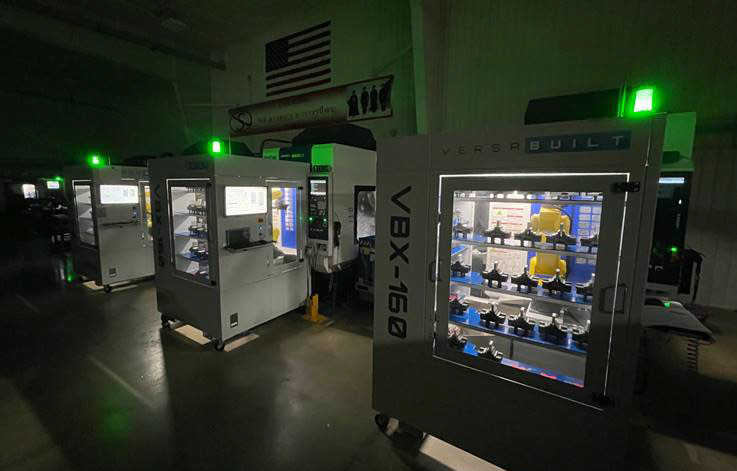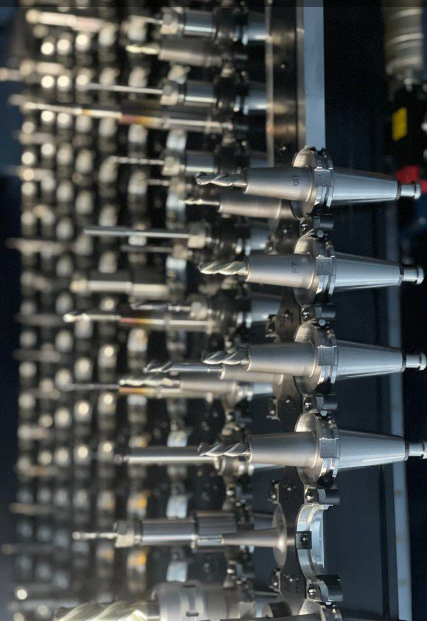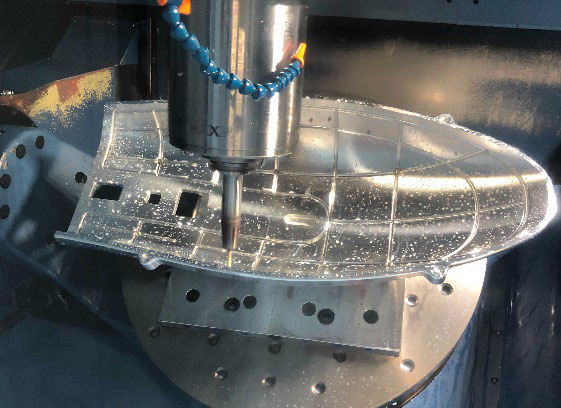
By JM Performance Products Inc.
Aerospace component manufacturing machine a lot of exotic alloys and hard metals like titanium in it products. A byproduct of utilizing these materials is that more pressure is put on the machines, spindles, and retention knobs. The result is that the tools must be changed out more frequently as they dull or break.
The cost of tool replacement, not to mention the loss of production time due to frequent changeover, can escalate costs as well−often to dizzying levels.
Flying S Inc. in Palestine, Ill., was looking to solve these problems and expand its capabilities. The aerospace/aviation industry-focused engineering company founded in 2001 recently added more palletized five-axis machining center technology to handle the high-volume production and precision machining of complex, tight-tolerance parts out of titanium, stainless steel, and other difficult-to-machine materials.
Notably, as the five-axis parts they made for unmanned military and civilian aircraft, along with spacecraft, became more complicated, it became clear that greater machine capability was needed to achieve reliable, unattended operation.
 According to Flying S manufacturing engineer Peter Bowman, “Many of our space flight fittings require tight-tolerance features. Our lack of reliable positional accuracy and repeatability due to thermal growth, machine positioning or other variables, really took a toll on our efforts to consistently make a good First Part, and subsequent parts after that.”
According to Flying S manufacturing engineer Peter Bowman, “Many of our space flight fittings require tight-tolerance features. Our lack of reliable positional accuracy and repeatability due to thermal growth, machine positioning or other variables, really took a toll on our efforts to consistently make a good First Part, and subsequent parts after that.”
With the new five-axis CNC machining centers in place, including state-of-the-art models from Matsuura USA in St. Paul, Minn., and Brother Industries Ltd. in Nagoya, Japan, significantly higher torque and drawbar pressure was being exerted on their standard, low-cost retention knobs causing issues with the interface between the toolholder and spindle.
Consistently, standard retention knobs were coming loose as dimpling/grooving wear issues repeatedly appeared on the face of the knobs−thus requiring replacement on a regular basis.
Whereas machining is about eliminating variables, Flying S actively sought out a solution to resolve its retention knob issues. During a visit to IMTS (International Manufacturing Technology Show) in Chicago, Bowman witnessed an expanding taper demonstration by JM Performance Products Inc. (JMPP) in Fairport Harbor, Ohio, which featured its patented High Torque retention knobs. Uniquely, the knobs were designed and engineered to eliminate the toolholder expansion responsible for costly and ongoing CNC milling and boring issues.
A manufacturer of CNC mill spindle optimization products since 2009, JMPP’s retention knobs feature a relief beneath the precision pilot that forces the threads of the knob deeper into the threaded bore of the toolholder–where a thicker cross-section of material resists the expansion and deformation.
With their multi-axis and unattended operations expansion commitment in full force, Flying S set out to standardize their entire line of CNC machines with JMPP’s retention knobs, to overcome catastrophic failure as a result of metal fatigue and other high load force-related issues associated with difficult to machine materials and long tooling.
Multi-axis / multi-issue variables
Today’s CNC mills, like Flying S’s multi-axis machining centers, are designed to operate with greater drawbar pressure, faster tool changes, higher feed rates, and greater depths of cuts, which places more demand on retention knobs in V-Flange tooling than ever before.
Flying S was able to address the following key issues via JMPP’s retention knobs.
Titanium challenge
Superalloys and exotic materials such as stainless steel, aluminum, and titanium are on the rise for component manufacturing in vital growth industries such as aerospace, medical, and automotive.
A unique set of production machining challenges ensue since high speeds typically in excess of 20,000 RPMs are often required. Notably, vibration and chatter can occur at these rates of speed, leading to poor surface finishes that require secondary bench operations or result in critical damage to expensive workpieces.
 Stability is an essential factor for improving milling performance on demanding materials like titanium–as the entire machining process has to be considered. Any one element could impede the overall process’s effectiveness as the tool, toolholder, spindle, column, ways, table, fixturing, and workpiece are all part of the interconnected ‘machining circle’ that requires stability to achieve optimal results.
Stability is an essential factor for improving milling performance on demanding materials like titanium–as the entire machining process has to be considered. Any one element could impede the overall process’s effectiveness as the tool, toolholder, spindle, column, ways, table, fixturing, and workpiece are all part of the interconnected ‘machining circle’ that requires stability to achieve optimal results.
Retention knobs are the critical connection between your machine tool and the tool holder, and they are the only thing holding a steep taper tool holder in the machine’s spindle. However, often retention knobs are overlooked by many shops, with a greater focus placed on havting a high-quality machine tool, top-of-the-line tool holders, and the latest high-performance carbide tooling. Then, ironically, they will break the loop by using economy retention knobs.
Notably, they go through thousands of tool changes which means they are subjected to very high pull forces from the spindle’s drawbar. Excessive torque tends to swell the metal around the retention knob, distorting the toolholder and creating a less-than-perfect fit between it and the spindle taper. Additionally, toolholder expansion caused by standard retention knob installation can reduce the toolholder-to-spindle contact by 70% or more. It’s no surprise that many machine tool builders specify the use of high-quality retention knobs for the best performance.
High torque solution
Yet, just having an expensive retention knob does not mean better performance. JMPP redesigned the standard retention knob into its patented High Torque retention knob which uses the lowest available threads in the toolholder. The pilot portion beneath the knob flange above the threads stabilizes the knob in the toolholder. The High Torque design includes a precision ground pilot, that ensures the perfect alignment of the knob in the holder during installation.
JMPP also manufactures all 30 and 40 taper retention knobs, including the patented High Torque knobs, from AISI 9310H material–offering 40% more tensile strength, instead of the traditional 8620H material.
TSC challenge
Deep-pocket drilling of exotic materials, like titanium, requires more coolant that acts like a high-pressure garden hose. This Through-Spindle Coolant (TSC) runs through a hole in the knob, which allows the coolant to run through the tool to the tip of the drill, thus helping to achieve heavier cuts, higher feed rates, deeper holes, and better surface finishes. It is often used for drilling into tougher materials like the ones used by Flying S in their aerospace applications. It also allows for better chip evacuation by forcing the chips out of the hole, thus improving process reliability.
As one can imagine, putting a hole in the center of the knob where the coolant runs through can cause major issues when using economy retention knobs since they are made from weaker materials. Often TSC retention knobs are where failures occur because of this design characteristic.
High torque solution
JMPP’s longer length and shorter threads mean less torque value and more leverage on the holder for high-pressure TSC−with less fretting on the holder or vibration. The size of the coolant holes has also been be sized to increase the cross-sectional strength of the knob.
Bowman noted that “We use JMPP’s knobs as standard for both TSC and non-TSC applications across the board because there is no need to swap them out when using TSC. It’s a safety measure for us. We would rather standardize so that ALL retention knobs are TSC capable, thus reducing the chance of trying to run high-pressure coolant on a non-TSC knob, thus flooding our spindles. What we found is that the knobs handle the force on the holder exceptionally well with no leaks at 1K psi and no signs of excessive wear.”
High-torque standardization
With the expansion of more state-of-the-art multi-axis machining centers, Flying S has implemented a standardization plan to exclusively utilize JMPP’s retention knobs. To date, they have roughly 2,000+ retention knobs in their shop’s operation including and featuring the following tool tapers:
CAT 30: Flying S currently uses BT30 TSC High Strength knobs in their Brother M140 and M200 machines. These are small spindle, high production 5-axis machines, typically with longer tooling requirements and robotically loaded, so the retention knobs work extremely hard, thus far with zero issues reported. See the picture of the 3 “Brothers” below.
CAT 40: The majority of Flying S’s tooling is CAT40, so it is midsized. They use these retention knobs in their 5-axis Matsuura and Haas products. Some of these machines by names are the Matsuura MAM72-70v 18 pallet, MX-850 4 pallet, MX-520 4 pallet, and MAM72-25v 40 pallet. Haas would be UMC-750 5 axis and numerous other vertical machines. According to Bowman, “To date, we’ve had no issues, as far as I’m concerned, and will only use JMPP knobs going forward.”
CAT 50: Flying S just purchased their first CAT50 machine, the Matsuura MAM72-100H−the largest 5-axis that Matsuura makes. The MAM72-100H is a beast, boasting a 6 pallet system, 245 tool magazines, horizontal 5-axis machining center with 1000mm of pallet swing. According to Bowman, “We will essentially be able to machine a 2 ½ ft square cube of stainless steel if we wanted to, which is wild. This machine will also use JMPP’s knobs exclusively.”
Machining complex parts are common in the aerospace and energy industries, with more companies investing in multi-axis machining centers that can match the demanding production challenges they face. As Flying S grows, they continue to invest in more advanced machines. As a result, they continue to see the value in having the right tools to protect and get the most out of those machines.
By implementing over 2,000 of JMPP’s High Torque retention knobs, every tool on Flying S’s machines works better and faster to make their demanding projects more competitively, reduce machine downtime, extend tool life and increase profit margins.
According to Bowman, “We were finding ourselves replacing the older $11 knobs on a regular basis. However, I have never replaced a single JMPP knob! Our standardization investment is great and I think it will last.”
Flying S has recently implemented an annual Preventative Maintenance Plan for all of their machines that use JMPPs’ hydraulic Clamp Force Gage Fixture to regularly check the clamping/pulling force of the drawbar. Drawbars are a high-wear item in CNC machines and are often overlooked as equipment ages.
As part of this program, they also use JMPP’s advanced Spindle Cleaner Kit that is designed to clean CAT and BT spindles in 30, 40, or 50 taper sizes.
Bowman also noted, “We also rented their Taper Shank Test Fixture that we saw at the IMTS show to prove to ourselves, and management, that we needed JMPP products. The test was pretty shocking and very convincing. We had no idea how much our “economy” retention knobs were costing us.”
Contact Details
Related Glossary Terms
- alloys
alloys
Substances having metallic properties and being composed of two or more chemical elements of which at least one is a metal.
- boring
boring
Enlarging a hole that already has been drilled or cored. Generally, it is an operation of truing the previously drilled hole with a single-point, lathe-type tool. Boring is essentially internal turning, in that usually a single-point cutting tool forms the internal shape. Some tools are available with two cutting edges to balance cutting forces.
- centers
centers
Cone-shaped pins that support a workpiece by one or two ends during machining. The centers fit into holes drilled in the workpiece ends. Centers that turn with the workpiece are called “live” centers; those that do not are called “dead” centers.
- chatter
chatter
Condition of vibration involving the machine, workpiece and cutting tool. Once this condition arises, it is often self-sustaining until the problem is corrected. Chatter can be identified when lines or grooves appear at regular intervals in the workpiece. These lines or grooves are caused by the teeth of the cutter as they vibrate in and out of the workpiece and their spacing depends on the frequency of vibration.
- computer numerical control ( CNC)
computer numerical control ( CNC)
Microprocessor-based controller dedicated to a machine tool that permits the creation or modification of parts. Programmed numerical control activates the machine’s servos and spindle drives and controls the various machining operations. See DNC, direct numerical control; NC, numerical control.
- coolant
coolant
Fluid that reduces temperature buildup at the tool/workpiece interface during machining. Normally takes the form of a liquid such as soluble or chemical mixtures (semisynthetic, synthetic) but can be pressurized air or other gas. Because of water’s ability to absorb great quantities of heat, it is widely used as a coolant and vehicle for various cutting compounds, with the water-to-compound ratio varying with the machining task. See cutting fluid; semisynthetic cutting fluid; soluble-oil cutting fluid; synthetic cutting fluid.
- fatigue
fatigue
Phenomenon leading to fracture under repeated or fluctuating stresses having a maximum value less than the tensile strength of the material. Fatigue fractures are progressive, beginning as minute cracks that grow under the action of the fluctuating stress.
- feed
feed
Rate of change of position of the tool as a whole, relative to the workpiece while cutting.
- fixture
fixture
Device, often made in-house, that holds a specific workpiece. See jig; modular fixturing.
- gang cutting ( milling)
gang cutting ( milling)
Machining with several cutters mounted on a single arbor, generally for simultaneous cutting.
- machining center
machining center
CNC machine tool capable of drilling, reaming, tapping, milling and boring. Normally comes with an automatic toolchanger. See automatic toolchanger.
- milling
milling
Machining operation in which metal or other material is removed by applying power to a rotating cutter. In vertical milling, the cutting tool is mounted vertically on the spindle. In horizontal milling, the cutting tool is mounted horizontally, either directly on the spindle or on an arbor. Horizontal milling is further broken down into conventional milling, where the cutter rotates opposite the direction of feed, or “up” into the workpiece; and climb milling, where the cutter rotates in the direction of feed, or “down” into the workpiece. Milling operations include plane or surface milling, endmilling, facemilling, angle milling, form milling and profiling.
- milling machine ( mill)
milling machine ( mill)
Runs endmills and arbor-mounted milling cutters. Features include a head with a spindle that drives the cutters; a column, knee and table that provide motion in the three Cartesian axes; and a base that supports the components and houses the cutting-fluid pump and reservoir. The work is mounted on the table and fed into the rotating cutter or endmill to accomplish the milling steps; vertical milling machines also feed endmills into the work by means of a spindle-mounted quill. Models range from small manual machines to big bed-type and duplex mills. All take one of three basic forms: vertical, horizontal or convertible horizontal/vertical. Vertical machines may be knee-type (the table is mounted on a knee that can be elevated) or bed-type (the table is securely supported and only moves horizontally). In general, horizontal machines are bigger and more powerful, while vertical machines are lighter but more versatile and easier to set up and operate.
- precision machining ( precision measurement)
precision machining ( precision measurement)
Machining and measuring to exacting standards. Four basic considerations are: dimensions, or geometrical characteristics such as lengths, angles and diameters of which the sizes are numerically specified; limits, or the maximum and minimum sizes permissible for a specified dimension; tolerances, or the total permissible variations in size; and allowances, or the prescribed differences in dimensions between mating parts.
- relief
relief
Space provided behind the cutting edges to prevent rubbing. Sometimes called primary relief. Secondary relief provides additional space behind primary relief. Relief on end teeth is axial relief; relief on side teeth is peripheral relief.
- sawing machine ( saw)
sawing machine ( saw)
Machine designed to use a serrated-tooth blade to cut metal or other material. Comes in a wide variety of styles but takes one of four basic forms: hacksaw (a simple, rugged machine that uses a reciprocating motion to part metal or other material); cold or circular saw (powers a circular blade that cuts structural materials); bandsaw (runs an endless band; the two basic types are cutoff and contour band machines, which cut intricate contours and shapes); and abrasive cutoff saw (similar in appearance to the cold saw, but uses an abrasive disc that rotates at high speeds rather than a blade with serrated teeth).
- shank
shank
Main body of a tool; the portion of a drill or similar end-held tool that fits into a collet, chuck or similar mounting device.
- superalloys
superalloys
Tough, difficult-to-machine alloys; includes Hastelloy, Inconel and Monel. Many are nickel-base metals.
- tensile strength
tensile strength
In tensile testing, the ratio of maximum load to original cross-sectional area. Also called ultimate strength. Compare with yield strength.
- toolholder
toolholder
Secures a cutting tool during a machining operation. Basic types include block, cartridge, chuck, collet, fixed, modular, quick-change and rotating.

